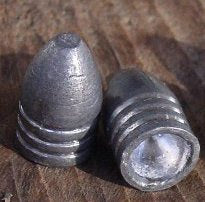 William Malcolm || One of the Oldest Names in American Riflescopes
William Malcolm || One of the Oldest Names in American RiflescopesThe telescopic rifle sight, better known today as the rifle scope, was first used on the long range muzzle-loaded target and hunting rifles of this country during the late 1830s and early 1840’s. Rifles like this .50 caliber modern copy produced by Davide Pedersoli & Company.
The earliest known telescopic rifle sights were built to the shooter’s eyesight, much like a pair of eye glasses – and were too expensive for most shooters of the time. Often, the hand-crafted rifle optics ended up costing more than the rifle it was being mounted on.
The need for such a sighting system grew as American shooters also refined yet another shooting innovation – the elongated conical bullet.
 Prior to the 1840’s, the patched round ball had been the standard projectile for muzzleloading rifles, and due to the inferior aerodynamics of the lead spheres, shooting was pretty much limited to ranges inside of 100 yards.
Prior to the 1840’s, the patched round ball had been the standard projectile for muzzleloading rifles, and due to the inferior aerodynamics of the lead spheres, shooting was pretty much limited to ranges inside of 100 yards.

However…with the development of rifles built with a faster rate of rifling twist for better stabilization of a projectile that was typically two to three times longer than in diameter, American shooters began to stretch out the distances being shot.

Shooting heftier charges of black powder behind long and heavy soft lead bullets, which could weigh 400 to 500 grains, target shooters of the late 1840’s and early 1850’s typically shot at distance of “40 rods”… which is 220 Yards. Thanks to the magnification of those early telescopic rifle sights, many top shooters were able to keep 10 shots at that distance inside of two to three inches.
In those days, shooting was America’s past time, and the introduction of the William Malcolm rifle scope in 1855 made it possible for just about every serious shooter to enjoy the benefits of magnifying rifle optics.
The scopes produced at Malcolm’s manufacturing facility in Syracuse, New York featured cold-drawn steel bodies, fully achromatic glass, and an adjustable eye-piece. The benefits of the cold-drawn steel tubes extend beyond simply being very durable. They allowed for finer tolerances when fitting lenses and mounts. The fully achromatic glass eliminated the color fringing effect that commonly plagued older lenses made of poor glass. When you combine those features with an adjustable eye piece, telescopic rifle sights could be quickly and easily adjusted for just about any shooter’s eye sight. No longer did the lenses have to be custom ground and polished to the individual shooter’s eye sight.
The William Malcolm scopes were soon stocked and sold by gunsmiths, gun shops, and general mercantile stores across the country. Such sights were now affordable for all shooters, selling for just a fraction of what a shooter had to pay for a quality rifle.
Malcolm’s scopes were so revered by the early 1860’s, that many were put into service aboard military Sharpshooter’s rifles during the Civil War. Several companies of the long-range marksmen were outfitted with heavy-barreled muzzleloading rifles and a few revered percussion breech loading rifles … complete with one of Malcolm’s long telescopic rifle sights.

Jim Leatherwood, founder of Leatherwood Optics and inventor of the ART system, was fascinated by vintage riflescopes and wanted to bridge the gap between period correct and modern optics. After nearly 14 years of research and development, Leatherwood reproduced the first generation of the modern William Malcolm 3/4" steel tube scopes. Since 2006, Leatherwood has been manufacturing vintage period correct telescopic sights under the brand Malcolm Optics.

Prior to the introduction of these modern production copies, there were a few makers crafting scopes of this period design. These were built by hand … at a cost of $1,000 to $1,500 … and took a year or more to have built.
As simple as these scopes may seem, they are time consuming to build. Inside that long steel tube of the circa 1855 Malcolm scope are SEVEN precisely placed and solidly mounted modern multi-coated lenses.
In spite of the small ¾-inch diameter steel tube, the scope's sight picture is still exceptionally bright, due to the lens coatings. And…thanks to the high quality polishing of those lenses, the sight picture is bright and sharp. Adjusting the focus of this scope to your shooting eye takes just a matter of seconds, allowing different shooters to enjoy shooting your rifle and precisely hitting their target.
Bearing the same name as the historic 1855 riflescope manufactured by William Malcolm, Malcolm Optics strives to keep the legacy going, endeavoring to manufacture affordable, authentically styled, and reliable optics for vintage muzzleloading, breechloading and lever action rifles.